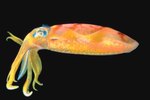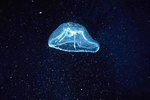They might have looked like something straight from the imagination of Jules Verne, but these sea monsters were real. Fortunately you don't have to worry about encountering them in the ocean today, since these ancient insectile creatures lived and died millions of years ago, taking with them their beastly spiked pincers and dagger-like tails.
Arthropod
The sea scorpion is a marine arthropod that lived more than 400 million years ago, leaving behind a fossil record. Formally known as Eurypterida, the sea scorpion is classified as an arthropod because it had an external skeleton, jointed legs and a sectioned body. Modern-day arthropods include lobsters and crabs, and the sea scorpion is related to the horseshoe crab as well as the land-dwelling scorpion. It takes its name from its fearsome appearance, including a whip-like tail and large claw-like pincers. It lived primarily on the ocean floor and fossil evidence of sea scorpions has been found worldwide.
Size
Sea scorpions came in all sorts of sizes, from tiny 4-inch specimens to those more than 6 feet long. One sea scorpion fossil found in Germany in 2007 led scientists to calculate that the entire specimen would have been over 8 feet long, or the size of a hefty crocodile. The measurements placed the particular creature at 18 inches longer than any previously discovered sea scorpions. This massive size is the exception, however, and most sea scorpion fossils are less than 8 inches long.
Predator
Scientists long believed that sea scorpions were among the top predators in the sea during their time. A group of scientists and engineers working together in 2010, however, determined that the intimidating claws were not used for hunting, but to hold on to food while eating. They found that the shape and design of the claw would not allow it to apply enough pressure to break through the plates of armored fish that lived at the same time as sea scorpions. This information suggests that instead of being predators, sea scorpions might have been scavengers.
Extinction
Sea scorpions have been extinct for about 250 million years. They died out during the Permian extinction, which was also responsible for wiping out more than 90 percent of ancient marine species. Scientists have several theories about what might have caused this massive extinction, including global cooling, formation of a supercontinent that changed the ocean habitat, rapid climate fluctuations and massive volcanic eruptions. Information about sea scorpions comes from the fossil record, with the largest deposit of such fossils found at Lockport, New York.
References
- Maryland Geological Society: Eurypterids
- Science Daily: Pterygotid Sea Scorpions: No Terror of the Ancient Seas?
- National Geographic News: Giant Sea Scorpion Discovered; Was Bigger than a Man
- University of California Museum of Palentology: Eurypterida
- University of Arizona: Arthropod Information
- University of Bristol: The Permo-Triassic Mass Extinction
Resources




